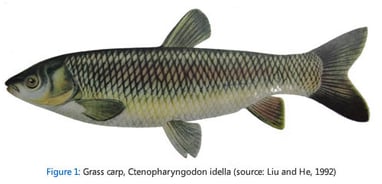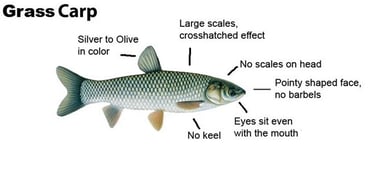Grass Carp Fish Farming
Grass carp live in lakes, rivers and reservoirs. It is a basically herbivorous fish that naturally feeds on certain aquatic weeds. Grass carp fish farming on a commercial basis is a profitable business in South Asian countries.
FISH FARMING
Grass Carp Fish Farming
Grass carp is a native Chinese freshwater fish. It inhabits lakes, rivers and reservoirs. It is a basically herbivorous fish that naturally feeds on certain aquatic weeds. However, the fry/larvae feed on zooplankton. Under culture conditions, grass carp can well accept artificial feed such as the by-products from grain processing, vegetable oil extraction meals, and pelleted feeds, in addition to aquatic weeds and terrestrial grasses. Grass carp normally dwell in a mid-lower layer of the water column. Comparatively, it prefers clear water and can move swiftly.
It is a semi-migratory fish. Flowing water and changes in water level are essential environmental stimuli for natural spawning. The fish can reach sexual maturity under culture conditions, but cannot spawn naturally. Hormone injection and environmental stimuli, such as flowing water are necessary for induced spawning in tanks. Grass carp grow rapidly and reach a maximum weight of 35 kg in the wild.
It has a wide body, a head that is almost circular and flat, a big cane, a small lower jaw and small eyes. Its colour is olive-brown on the dorsal side, with silver sides and the belly colour is white. Scales are large with dark edging. It can tolerate 40°C degrees of temperature. These species have long life duration and is popular in various countries because they offer a biological alternative to aquatic weed control. In Pakistan, this fish is prepared to lay eggs in the month of May and June. Depending upon their per kg weight it gives 0.80-1.00kg eggs. This breed eats 40-70% of feed according to their body weight.
Grass carp fish farming on the commercial level is a profitable business in some countries and areas, especially in South Asian countries. Its commercial production is becoming popular gradually.
Pond Preparation
The grass carp fish are commonly fed on aquatic plants. So, prepare the pond perfectly and have to ensure maximum aquatic plant production. For this purpose, sterile the pond first by applying lime then apply both organic and inorganic fertilizers to it for stimulating natural food production.
Seed supply
Artificial propagation is the major supply of seed for the culture of grass carp. natural seeds are not still available in rivers in Pakistan. Broodstocks used for artificial propagation are usually raised in captivity from breeding stations where good natural stocks are maintained.
Hatchery
Matured breeders are released into the spawning tank (round cement tank with a diameter of 6-10 m and water depth of around 2 m) after being injected with inducing hormone. Water circulation is maintained throughout the spawning period. Eggs are transferred to hatching raceways or jars, either manually or by gravity. Hatching raceways are commonly used for large-scale production. The width of the raceways is normally 0.8 m and the depth is 0.8-1.0 m. The inlets are mounted on the bottom of the raceways with openings in the same direction and at an angle of around 15° to the bottom, to promote water circulation. Water can be totally drained out through the outlet on the bottom. Current flow is maintained during the hatching period to keep the eggs and larvae suspended in the water column.
Nursery
Earthen ponds (usually 0.2-0.4 acre and 1.5-2.0 m deep) are used for the nursing of grass carp. Ponds are chemically cleared, normally with quicklime, to eliminate all harmful organisms. Organic fertiliser, animal manure and green manure are commonly applied 5-10 days before the stocking, to increase the natural biomass of algae and zooplankton. The quantity of organic fertiliser used is usually 1000 kg per acre for animal manure or 2500 kg per acre for green manure. Green and animal manures can be used simultaneously but the quantity of each should be reduced accordingly.
The fish are fed with aquatic weeds/terrestrial grasses and pelleted or other commercial feeds. The culture period is usually 8-10 months and gains a weight of 1.5 to 2 kg each. Grass carp usually account for 60-70 per cent of the total production.
Stocking
When the fingerlings reach around 13-15 cm in body length they become ready for stocking in the main pond. The grass carp fish is generally stocked in the pond with other carp fish species. the stocking density of grass carp fish with other fish species can be 2,000 to 3,000 per acre and here in pakistan, it can be stocked from 100 to 500 per acre.
Feed
Grass carp are reared with commercial feeds or natural food, such as aquatic weeds and grasses. They prefer relatively low fertility. Production is mainly limited by water quality. The commercial feeds used for grass carp are relatively low in protein (28-30 per cent) and their raw materials include soybean cake/dregs, rapeseed cake and wheat bran etc. Aquatic weeds can be collected from natural water bodies. Terrestrial grasses can be grown on the pond dyke with organic manure.
Harvesting
Both selective and total harvesting is practised for grass carp. Selective harvesting is usually conducted in the early morning (because temperatures are relatively low and for morning sales) during late summer and autumn. Individuals of marketable size are selected after netting (a single netting for each harvest). Total harvesting is carried out at the end of the culture period. Several nettings are usually carried out before the total drain-down of the pond. All the fish are harvested at the end of the year, either for marketing or for restocking (individuals below marketable size) for the next production cycle.
Conclusion
Grass carp is economically significant and many people are doing business by farming grass carp fish. The fish farming business is an excellent source of employment for rural people. Usually, the grass carp is raised in mud ponds but nowadays people are growing it in tanks. Therefore follow the above steps for grass carp fish farming in an economical way.




